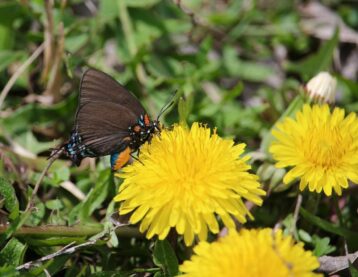Did you know that you can do a lot for pollinators by simply mowing less? All the while, saving time and money.
RESIDENTIAL LAWNS
Studies have shown that if you mow every two or three weeks, your once barren yard can become a buffet for pollinators in just a few short weeks. You will see quick-blooming “weedy” flowers sprout up from the soil. Instead of treating weeds like unwanted invaders, to help save our native pollinators, treat them like welcomed guests! They’ll beautify your lawn for a few days at a time all throughout the growing season and they’ll do it for free. All it takes is giving them a bit more time between mowing to put up their flowers. – Atticus Murphy, Tufts Pollinator Institute

What types of flowers will spontaneously grow in your lawn? It’s hard to say, and that’s part of the fun! In Oklahoma, you might expect to see pollinator-friendly flowers such as dandelions, clovers, henbit and other quick-blooming, low-growing species.
Many of these species may not be native, but they are nevertheless sources of nutrition for our native pollinators. So if you’re interested in helping pollinators but don’t want to make the leap into pollinator-friendly gardening just yet, welcoming some “weeds” into your life is a great first step towards making your property a refuge for native pollinators.
Want to see more flowers? An easy way to add more color to your lawn mullet is to add native wildflower seeds in late fall. First, mow and weedeat your designated lawn area as short as possible…until you see dirt if possible. Then, sprinkle and stomp in a light mix of soil and native wildflower seeds. Lightly water the area. Come spring, you’ll have beautiful native wildflower blooms to admire and the pollinators will love you for it!
Give what you can. Customize your lawn habitat to your comfort level. Whether it’s a small, medium or large portion of your yard, native pollinators will benefit.
Avoid Complaints
What can you do to ensure success not only with your garden, but with your municipality and with your neighbors?
IT IS IMPORTANT TO:
- Be aware of municipal ordinances and homeowner associations rules and regulations.
- Communicate with neighbors.
- Avoid common areas.
- Have clean lines/borders.
- Omit invasive and noxious species.
- Post habitat signage.
Lawn Mullet
One popular way to avoid complaints is to host habitat in your backyard, also known as a “lawn mullet”. This strategy involves keeping the front yard trimmed low, while hosting a pollinator garden and/or taller lawn in the back. Business in the front, pollinator party in the back.
> Learn more about strategies to avoid complaints and keep neighbors happy.
LARGE SCALE HABITAT
Mowing can be an effective management tool to control woody and weedy species and manage undesirable species from setting seed. Mowing also may stimulate the growth of desirable nectar plants. However, mowing too often or during certain times of the year may result in higher mortality for wildlife, including monarchs and other pollinators. Monarch eggs, larvae, pupae and even adults may be killed directly by the mower, and mowing can remove critical habitat for monarchs and other species. To limit monarch mortality, use the following recommendations:
-

Monarch nectaring on dandelions in Yukon, OK. By John Leonard. Avoid mowing the entire habitat. Leaving refuge areas for wildlife will allow for recolonization of the mowed site. Leave areas that may be good nesting or overwintering sites (leaf litter, dead stems, other ground cover) for pollinators or other wildlife. Marking habitat areas may prevent accidental mowing, and signage helps communicate why an area is not mowed.
- Avoid mowing monarch habitat when monarchs are present (see Recommended Management Timing map above). Mowing milkweed mid-summer in areas where there is a lull in monarch activity, such as the Southern Great Plains, may promote milkweed growth and late summer or early fall breeding (Baum and Mueller 2015; Fischer et al. 2015). Always survey for monarchs before conducting mid-season mowing.
- Mow after native plants finish blooming and dispersing seed.
- Mow once or twice per year. Consider mowing within an integrated vegetation management framework on just the areas of heaviest weed infestation. Mowing too frequently disrupts growth and the ability of flowering plants to compete with grass. During the first year of some restoration projects (e.g., prairies), more frequent mowing may help with weed control. Many DOTs have adopted deferred mowing programs to benefit monarchs and other species.
- See Okies for Monarchs’ “Best Management Practices for the Monarch Butterfly in Oklahoma Rights-of-Way”.
- Use a minimum cutting height of 10-12 inches (shorter may be needed for early establishment mowing). This effectively removes seed producing parts of most invasive plants and minimizes wildlife impact.
- Use a flushing bar and cut at reduced speeds to allow wildlife to escape prior to mowing.
- See Okies for Monarchs’ “Best Practices for the Monarch Butterfly in Oklahoma’s Rangelands”
See Monarch Joint Venture’s handout titled “Mowing: Best Practices for Monarchs” for additional information including regional time frames during which management activities may be less detrimental to local monarch populations. While the document is targeted for mowing best practices, the timing windows are applicable across different management techniques as well.

